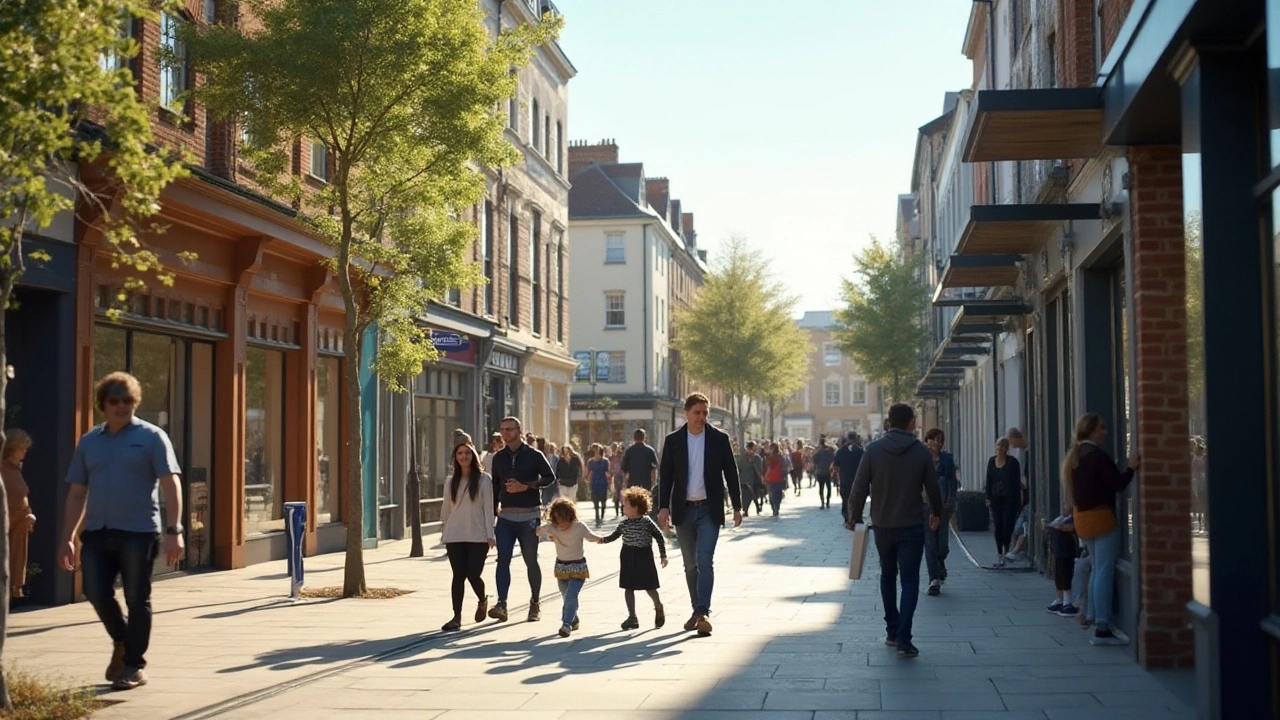For many people, owning a home is a lifelong dream. In 2025, this dream remains attainable in certain parts of the world where property prices are surprisingly low, offering both first-time buyers and seasoned investors a chance to enter the market without depleting their savings.
In this article, we'll delve into some of the most affordable places to buy property. From bustling cities in developing countries to quaint villages in the countryside, these locations offer unique opportunities for those willing to look beyond traditional hotspots. By understanding what makes these markets tick, you can make informed decisions as you embark on your property investment journey.
- Emerging Markets Offering Affordable Housing
- Hidden Gems: Rural Regions with Low-Cost Properties
- Economic Factors Influencing Property Prices
- Tips for First-Time Buyers in Affordable Markets
- Future Trends in Budget-Friendly Real Estate
Emerging Markets Offering Affordable Housing
In a world where property prices often feel like they are spiraling out of control, savvy buyers are turning their attention to emerging markets. These vibrant regions are often characterized by affordable housing prices, which can be a gateway to significant investment opportunities. In many developing countries, urbanization has led to bursts of activity in real estate markets. This growth typically happens because people are moving from rural to urban areas, seeking employment and better living conditions. With this shift comes an increase in demand for housing, creating a fertile ground for property investment.
Take, for instance, countries in Southeast Asia, such as Vietnam and Cambodia. These nations have seen rapid growth in their economies, which has been mirrored by their real estate markets. Vietnam, with its young population and open-door policy advocating foreign investments, has become a hotbed for purchasing cheap homes. Cities like Ho Chi Minh and Hanoi have seen unprecedented growth, yet property remains accessible compared to Western standards.
"Vietnam’s economy continues to grow, and with it, the opportunities in real estate are both broadening and deepening," notes Richard Leech, Executive Director at CBRE Vietnam.
Similarly, Latin America showcases several emerging markets where housing is still cost-effective. Places like Medellin in Colombia and Guadalajara in Mexico stand out as cities offering not only affordable property but also a rich cultural backdrop that appeals to expatriates and locals alike. These locations often see a thriving cultural scene and a burgeoning middle class, both of which contribute to their appeal. Buying property in such markets can be more than just a financial decision—it can also be an investment in lifestyle.
Factors Making These Markets Attractive
The affordability in these emerging markets is typically driven by several factors: relatively low labor costs, cheaper materials, and government incentives for real estate development. Properties are also more affordable because many of these economies are still developing and have not fully appreciated in line with global benchmarks. Moreover, political stability and supportive governmental policies towards real estate investment offer a safety net for foreign investors, making these locales particularly attractive.
One cannot overlook the importance of conducting thorough research before diving into these markets. Potential buyers should take the time to understand the local real estate laws, the economic situation, and any potential socio-political risks. In certain areas, property taxes might be lower, or there may be incentives for new developments, all of which can impact the real estate deals you're able to secure.
Many emerging markets continue to offer investment opportunities that promise monetarily and an enriched lifestyle. As these areas grow and prosper, they often provide an exciting blend of modern amenities and cultural richness that cannot be easily found in more developed countries. For those willing to take a chance on these regions, the rewards can be significant, both personally and financially.
Hidden Gems: Rural Regions with Low-Cost Properties
The call of the countryside is more potent than ever for those seeking to escape the hustle and bustle of urban life. While city living has its perks, there's something undeniably attractive about breathing fresh air and enjoying acres of open space. And the best part? You can achieve all this without burning a hole in your pocket by exploring cheap homes nestled in rural regions around the globe.
One such place is in Eastern Europe, where countries like Bulgaria boast stunning rural landscapes dotted with traditional-style homes that come at a fraction of the cost compared to Western Europe's bustling capitals. The charm of villages with cobblestone streets and ancient churches adds an old-world allure that entices both locals and expats. These regions, while not teeming with high-rise buildings and shopping malls, offer a more peaceful way to live, with costs often well below $40,000 for a spacious single-family home.
In North America, some states are known for their affordable countryside real estate. Take, for instance, West Virginia, a destination where the median home price ranks among the lowest in the United States. Here, you can find homes surrounded by lush greenery and rolling hills that bring you closer to nature, yet stay within easy reach of amenities. These rural areas not only offer affordable housing options but deliver a lifestyle where community spirit thrives. And as a bonus, property taxes are often considerably lower, allowing you to maximize your investment.
"There’s something fundamentally soothing about rural life," says real estate expert Jane Thompson, "It invites a slower pace and creates opportunities for those looking to escape urban chaos without sacrificing the comforts of modern living."
Moving to rural South America provides similar benefits, with countries such as Uruguay offering lovely countryside homes that won't strain your budget. Many picturesque villages here have properties perfect for those looking to settle down or even retire comfortably. The mild climate and rich soil also make it an excellent spot for aspiring hobby farmers looking to get their hands dirty. Despite the language barrier, the welcoming local communities and thriving expat populations create a nurturing environment for newcomers.
Preparing for Rural Life: Key Considerations
Before you pack your bags and head to the countryside, it's important to weigh several factors. Accessibility can be a significant issue in rural areas; thus, it's worth considering the proximity to major roads and public transportation systems. Ensuring you have reliable internet and phone services is crucial, especially for remote workers. It might also be helpful to research the availability of healthcare facilities and educational institutions if you plan on relocating with family.
Rural properties often come with extensive land, so think about maintenance. Will you manage it yourself, or hire someone local? Familiarize yourself with property laws and potential restrictions related to land usage, especially if you’re keen on agriculture. Lastly, getting to know your prospective neighbors and community can provide invaluable insights, making the transition smoother and aiding in the decision-making process.
For those courageous enough to venture off the beaten path, these real estate deals in rural regions offer a unique chance to embrace a simpler, more serene way of life. With affordable price tags, these hidden gems beckon to be discovered, promising both peace and a promising future investment.

Economic Factors Influencing Property Prices
When it comes to understanding where to find cheap homes and snag the best real estate deals, economic factors play a crucial role. At the heart of these economic drivers is the balance of demand and supply, which dictates prices significantly. As economies expand, more people tend to seek housing, driving up demand. However, if construction and housing supply keep pace with demand, prices remain in check. If there is a mismatch, however—like rapid urbanization without adequately planned housing infrastructures—prices could surge unexpectedly. It's no surprise then that properties in rapidly growing cities like those found in Southeast Asia may see fluctuating prices based on these dynamics.
Interest rates are another pivotal economic factor influencing property markets. These rates, typically set by central banks, determine mortgage affordability. Lower interest rates can embolden potential buyers to enter the market, pushing property prices up due to increased competition. Conversely, rising rates often act as a brake, making loans more expensive and dampening demand. Understanding these trends is vital for anyone looking to invest in real estate in the current climate. For investors, keeping an eye on central bank policies could mean the difference between a high-yield investment and a financial stumble.
Currency value shifts can also influence real estate prices in countries that rely on foreign investment. In locations where local currencies are weak compared to major currencies like the dollar or euro, foreign investment often surges, as investors can get more property for their money. However, sudden shifts can create volatility. A case in point is the Turkish real estate market which, despite economic turbulence and currency depreciation, has remained appealing to foreign investors seeking capital gains and affordable housing compared to their home countries.
Government policies, including taxes and incentives, have a profound impact on property investment. Policies that support property ownership through tax breaks or subsidies can stimulate the housing market, making it more attractive for potential buyers and investors. On the flip side, high property taxes, as seen in urban areas like New York or London, can deter buyers and cool down the market. Moreover, regulations on foreign ownership can either welcome global investors or keep them at bay, directly affecting market dynamics. As noted by the International Monetary Fund, "Property markets are multifaceted and require consistent policy evaluation to ensure they don’t become a source of economic instability."
With globalization, economic health at a macro level cannot be overlooked. Global recessions can lead to tighter lending criteria, reduced employment, and thus, a decreased demand for housing. During the 2008 financial crisis, property prices in many parts of the world plummeted as buyers retreated, unable to secure financing amidst economic uncertainties. Conversely, economic booms, like the post-pandemic recovery seen in some regions, can spur housing demand as consumer confidence rebounds. As the world nears the halfway point in this decade, aspiring homeowners and investors keen on identifying affordable housing must keep these economic factors at the forefront of their decision-making processes.
Tips for First-Time Buyers in Affordable Markets
If you're venturing into the real estate world, especially for the first time, looking into affordable housing can be a savvy decision. Affordable markets present unique advantages not just for your wallet but also for exploring less competitive environments. However, navigating these waters requires some know-how. First and foremost, it's essential to thoroughly understand the local real estate scene. Not all affordable markets are the same; some may present rapid growth opportunities while others might stand still for years. Consider seeking advice from a local real estate agent who understands the intricacies and can provide insight into which areas are becoming up-and-coming.
Securing a property in a cheap homes market doesn't mean compromising on quality or your standards. It’s important to set a budget and stick to it, ensuring not to get swept away by initial low prices without looking at potential additional costs. Remember, properties often come with extra expenditures, like renovation needs, property taxes, and insurance. Make sure you've got all corners covered so you won’t face unexpected surprises down the road.
Brian Stevens, a renowned real estate advisor, once remarked, "The key to thriving in any property market isn't just about finding the lowest price, it's about understanding the full financial landscape."Balancing what you can afford with what's available and meeting your long-term needs is a critical step in making a wise investment.
Moreover, before purchasing, consider aspects beyond the property itself, such as the community and potential for appreciation. Investigate the local economy, employment rates, and infrastructure developments. Places with burgeoning industries or incoming business projects might offer substantial growth potential in real estate values. Researching the area’s history and projections can provide clarity on future property conditions. Analyzing these factors can paint a picture of how your investment could evolve over time, ensuring your decision aligns not only with your current needs but with future aspirations.
Financing is another crucial element to explore. In many real estate deals, the financial aspect can be as important as the actual property hunt. Investigate various mortgage options available in your target area and engage with lenders knowledgeable about the local market. Utilize pre-approval simulations to get an idea of what your borrowing power is. It’s wise to look into government-backed programs or incentives for first-time buyers that can ease the financial burden. Establishing a relationship with a local financial advisor can make navigating this landscape markedly easier.
Finally, embrace the potential of community connections. Speaking with residents can provide invaluable insights about living conditions that aren't listed in brochures or online forums. They might share relevant anecdotes about the neighborhood, safety, amenities, and community activities. By connecting with locals, not only do you gain a clearer picture of everyday life in the area, but you could also form connections that ease the transition into a new home. With a little research and a lot of curiosity, buying in an affordable market can turn into a rewarding chapter of your life journey.

Future Trends in Budget-Friendly Real Estate
As the world continues to navigate through economic uncertainties, the quest to find cheap homes becomes ever more pressing. In recent years, technological advancements and shifting societal priorities have begun to mold the landscape of affordable housing. One notable trend is the rise of smart homes in the property investment arena, where technology integration doesn't necessarily mean a hefty price tag. More developers are exploring cost-efficient and eco-friendly construction methods, enabling even budget-conscious buyers to enjoy modern amenities. Pre-fabricated housing units, for example, are gaining traction for their ability to reduce construction costs significantly without sacrificing quality.
The spike in remote work is another catalyst reshaping affordable housing. As work-from-anywhere becomes the new norm, people are no longer tethered to city centers, opening up a plethora of opportunities in rural or suburban environments. These areas traditionally offer more space for less money. The decoupling of work from geographic location has led to a trend whereby families and individuals seek larger properties away from the hustle and bustle at reasonable prices, thus driving demand in these low-cost regions.
"The pandemic has fundamentally altered the real estate market," notes economist Jane Whitley. "With the rise of remote work, many individuals are moving to cheaper locales where they can get more bang for their buck."On the financial side, we observe lenders are crafting new products that cater specifically to these changing dynamics. Flexible mortgage options, co-op financing models, and even fractional ownership schemes are being tested, allowing more people to step onto the property ladder and reap the benefits of real estate deals.
Interestingly, data analytics and AI are beginning to play crucial roles. These tools help potential buyers evaluate properties by forecasting value appreciation, analyzing neighborhood trends, and even calculating renovation costs up front. This could markedly enhance decision-making and potentially turn the tides for those eyeing cheap homes. We should also watch the policy shifts, as governments worldwide experiment with incentivizing property developments in budget-friendly locales. Such initiatives include tax breaks, subsidies for first-time buyers, and relaxed zoning laws, all poised to make affordable housing more accessible.
Looking ahead to 2030, the focus on sustainability is expected to intensify. Today's budget-friendly housing trends hint at a future where affordability and environmental concerns go hand-in-hand. Green buildings, energy-efficient appliances, and self-sustaining communities could become prevalent as consumers and developers alike prioritize Earth-friendly solutions without straining pockets. Thus, embracing these trends could unlock exciting opportunities in the ever-evolving world of budget-friendly real estate deals.
